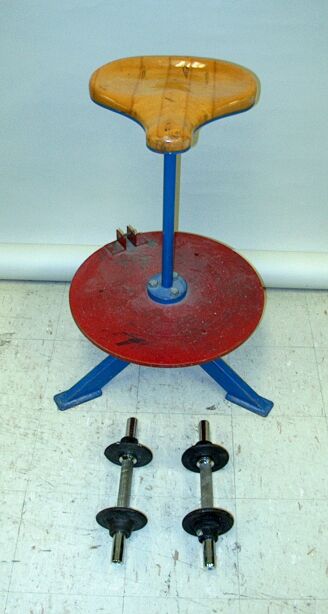
With a dumbbell in each hand, sit on the stool, and with a foot on the floor, give a push to start spinning. As you extend and retract your arms, the speed at which you spin decreases and increases, respectively.
Just as linear momentum is conserved for processes involving objects undergoing linear motion, so is angular momentum conserved for objects that are rotating. Whereas the linear momentum of an object equals mv, where m is the mass of the object, and v is its velocity, the angular momentum of an object equals Iω, where I is the object’s moment of inertia, and ω is its angular velocity. (Strictly speaking, these are vector quantities, mv and Iω. In what follows, we will consider the magnitudes only, and treat v, ω and their respective momenta as scalars.)
All points on a rigid body rotating about a particular fixed axis have the same angular speed, ω, but an instantaneous linear speed, v = ωr, where r is the distance of a particular point from the axis of rotation. Since any point on the object travels in a circle about the axis, its angular momentum, l, equals mvr, which equals mr2ω. If we add the momenta for all the mass points on the rotating body, we find that its angular momentum is L = Σ miri2ω. Since ω is the same for all points on the object, we can write L = (Σ miri2)ω. The sum in parentheses is the rotational inertia, or moment of inertia, which we call I, and L = Iω. We can also see this by considering the kinetic energy of each mass point, which equals (1/2)mv2 = (1/2)mr2ω2. For the whole body, the kinetic energy is the sum of the kinetic energies of all of the points, or K = (1/2)(Σ miri2)ω2. Again, the quantity in parentheses is I, the moment of inertia.
Since the sum that makes up I contains products of mr2, we can see that the moment of inertia of an object depends both on the orientation of the axis about which it rotates, and on the object’s shape and its distribution of mass. Its units, mass·length2, are usually expressed as kg·m2, g·cm2 or slug·feet2.
Take a dumbbell in each hand, sit on the stool, and with a foot on the floor, give a push to start yourself and the stool rotating. Now, if you extend your arms to move the dumbbells outward, you increase r for the dumbbells, and thus their contribution to I, the moment of inertia of the system comprising you and the stool. Since the angular momentum, Iω, must remain constant, and you’ve increased I, ω, the angular velocity, must decrease. Thus, as you move the dumbbells outward, the speed at which you and the stool rotate decreases. Conversely, if you now bring the dumbbells in, close to your axis of rotation, this decreases r for the dumbbells, and thus their contribution to I. To keep angular momentum constant, ω must now increase, so the speed at which you and the stool rotate increases.
Ice skaters (and ballet dancers, divers and others whose activities involve rotation) use this phenomenon to control the speed at which they rotate during certain maneuvers, most obviously extended pirouettes, during which the skater increases his speed of rotation by bringing his arms (and free leg) in, and slows down his rotation by extending them outward.
Note that while the angular momentum, Iω, of the system that comprises you and the stool remains constant as you move the dumbbells in and out, the kinetic energy, which equals (1/2)Iω2, does not. As you move the dumbbells outward, the resulting decrease in ω lowers the kinetic energy of the system, and as you pull the dumbbells inward, the resulting increase in ω raises its kinetic energy. This change in kinetic energy comes from the work that you do in moving the dumbbells outward (negative work) and inward (positive work).
References:
1) Resnick, Robert and Halliday, David. Physics, Part One, Third Edition (New York: John Wiley and Sons, 1977), pp. 237, 268-70.
2) Sears, Francis Weston and Zemansky, Mark W. College Physics, Third Edition (Reading, Massachusetts: Addison-Wesley Publishing Company, Inc., 1960), pp. 186.